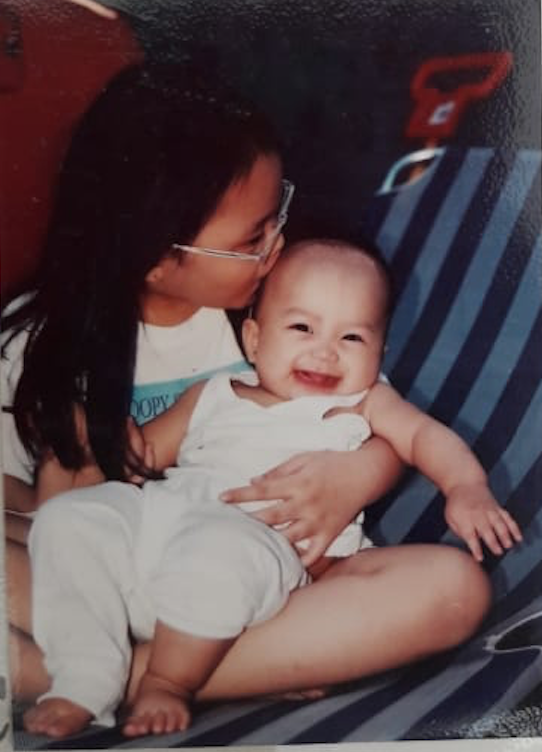Apr 21., 2019 / General, Homilies, Soul Food
What Love Embraces
This essay first appeared on print on Easter 14 years ago in Sr. Cecille’s column “Solid Places” in the Sunday Inquirer Magazine. Beatriz is now a lovely, healthy 14 year-old.
Joy and sorrow are sisters; they live in the same house.
– Macrina Wiederkehr
There is a pervasive attitude in our world today, which seeks to deny anything that would remind us of our mortality. We run away from wrinkles and thinning hair with the same fervor we display in trying to escape the more invisible diminishments in our lives. This is most evident in our postmodern pathological denial of the inevitability of suffering and the rightful place of sorrow in life. But if we are to know the depths of joy, if we must truly love (which is our most difficult and ultimate task, according to Rilke), then we must learn to accept the visitations of sorrow.
This reminds me of a little story: It was supposed to be just another routine prenatal check-up. The young mother was on her ninth month, only a week till full term. It was her second child too, a much prayed for and long-awaited one. Her eldest daughter, a precocious 6-year-old, had been bugging her parents for a baby sister, and she was finally getting her wish. “Beatriz,” that was the name they had chosen. But the visit turned into confinement: apparently the mother’s body was all primed to deliver, but the baby was not quite ready to come out yet. They had to wait a few more days. The labor and delivery turned out to be a breeze, and she delivered a beautiful baby girl. It was all routine.
There were disturbing signs, however. The other nursing mothers in the rooming ward had gushed at how quiet her daughter was, while theirs squalled lustily, but the mother was a little uneasy. Her tiny baby took only a little milk, and would just whimper softly. On the day they were supposed to come home, the pediatrician noticed that little Beatriz was very ruddy, which was disquieting since both her parents were fair-skinned. And so another consultant was called, and soon tests were made. At this point, things unraveled quickly for the bewildered and shocked parents: there was something terribly wrong with their newborn daughter, and the doctors suspected a blood disorder and a viral infection. She was also jaundiced. A blood culture was ordered, and since the hospital did not have the facilities for it, the father had to rush to another hospital to have it done. It was 2 a.m. by this time. Back in the hospital, Beatriz was having convulsions because of her high fever. Her mother remembers the scene well: “It is so terrible for a mother to see her own baby suffer like that, and to be helpless about it. All you could see were doctors and nurses surrounding her, just this moving, frantic wall of white coats and uniforms… l couldn’t see her anymore. It is the most awful feeling in the world, to know your child is in danger and not even SEE her… the memory burned that image forever in my brain.” A different sight greeted the father, when he returned to the hospital. He saw his little daughter, now in the neonatal intensive care unit, with assorted tubes attached to her tiny body, her eyes blindfolded to protect them from the photolight therapy. He took one look at his baby, and broke down and cried.
The initial shock and horror at this turn of events gave way to a long, equally painful vigil. The blood culture took five days, and until then (the doctors said), they must wait and pray. Family and friends rushed to the hospital, but there was really little they could do or say. For what words can they speak to make any sense out of the suffering of an innocent baby? And what else can they do but relieve the parents of some of the practical details of a hospital confinement? The weight of a powerless, painful waiting for the fate of their child, and the struggle to find meaning out of the utter senselessness, was theirs alone. They clung to each other, and to their faith, She refused to leave her baby’s side, and when her blood pressure soared and she was banned from the sterile area, she waited outside the door everyday, praying. He sought refuge in the hospital chapel, sometimes falling asleep there, his 6’0″ frame squeezed in the narrow pew, one arm clutching the back of the pew as if it was a lifeline, like a man lost at sea.
Only love can understand such words, and only faith can give the courage to see beyond love’s present suffering.
When the blood results came back, it was discovered that Beatriz had polycythemia, which means her blood was “too much and too thick.” She needed partial exchange transfusion round the clock. She also had klebsella ozaenae, a viral infection that proved resistant to the antibiotics that she was being given, and so a new round of more powerful drugs was started. The days stretched with an awful, surreal, slow-mo quality: the father would visit her in the morning before he went to work, and her IV would be in her foot, and when he returned in the afternoon, it would be in another part of her body. Her veins were so tiny they kept collapsing. It broke his heart every time.
Still, they kept their faith. After one of their baby’s convulsions, the mother wept as she told me what
had happened. After a moment, she quietly. painfully said: “Do you know what her name ‘Beatriz’ means? It means ‘Bearer of joy’ I know that even now, she is living up to her name.” Only love can understand such words, and only faith can give the courage to see beyond love’s present suffering.
After nearly two weeks in the neonatal intensive care unit, Beatriz was declared out of danger. She was finally brought home, with much collective joy, relief and gratitude,
and baptized the very next day. Last Easter she came to the Cenacle for the Easter Vigil Mass. When I saw her hopping and toddling about, clutchIng her unlit Easter candle and chortling happily like the healthy 1 year-old that she is, I cannot help but remember all that she, her parents and family had gone through. Her birth and her brush with death is a littte Easter story, I realized.
Joy and sorrow are truly sisters, and love embraces them both.










